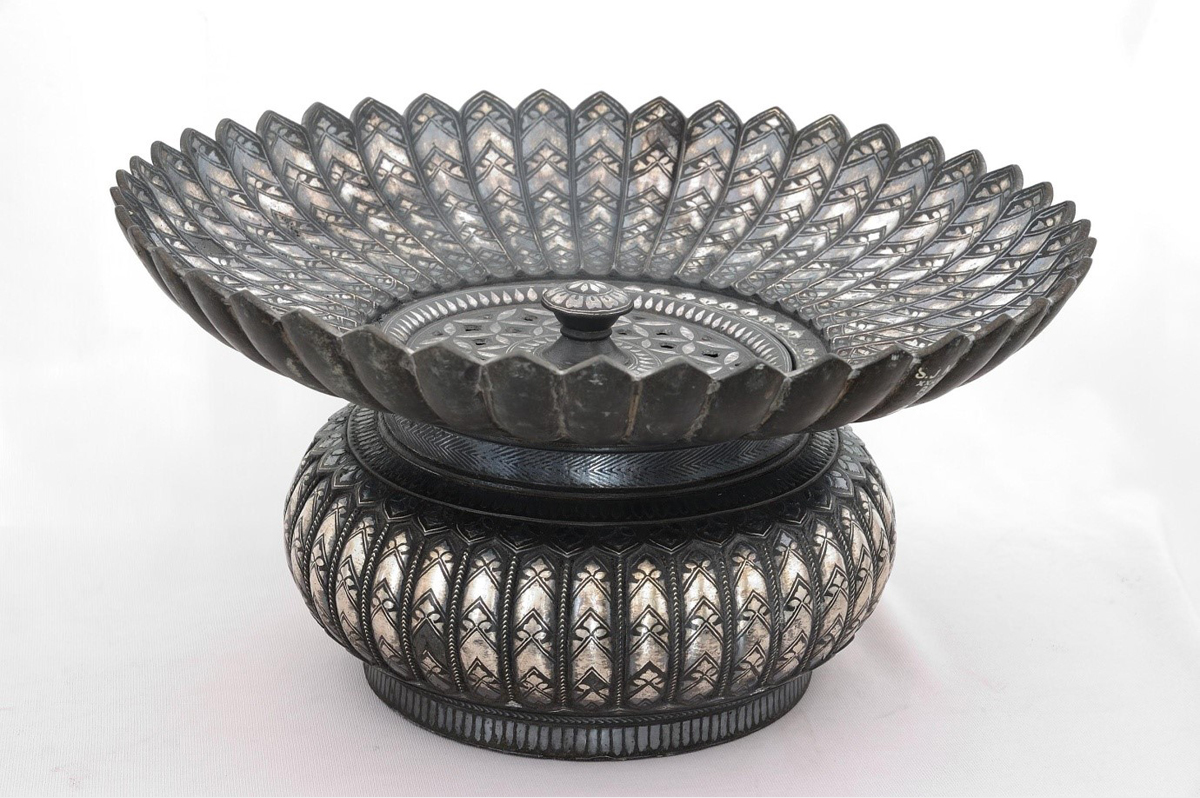Central Block, First Floor
- Home / Galleries / Central Block, First Floor / Bidri Ware
Bidri Ware
A very significant contribution other than in the field of paintings made by Persian and Near East art in the Indian cultural sphere is the application of exquisite decorations on articles of daily use. A major item in the latter category is ‘Bidari or Bidri ware’ originating from the city of Bidar, 80 kms from Hyderabad, now in Mysore, Karnataka.
Bidri ware dates back nearly to four hundred years to the “Bahamani and Baridi dynasties.” Under whose patronage it flourished and towards the end of whose rule it reached its greatest perfection and beauty.
The basic material is an alloy of Zinc, copper and lead, other than materials like Iron, or copper which were generally used by Persian craftsmen for inlay work. This combination of Zinc and copper does not rust nor corrodes but is brittle at the same time.
The close of 18th century witnessed the bad days of Indian traditional art, as they came under disfavor of the nobility, who were the patrons of art for centuries. The market of Hyderabad was full of collections of priceless Bidri ware of earlier designs casts away from the houses of the aristocrats. They however caught the eye of British officers under the Nizam’s service. Like E.B Havel, who worked hard for the re-introduction of traditional Indian art in painting, also prof. E.E. Speight of Osmania university, Hyderabad who tried for the revival of Bidri ware. Bidri articles changed their shapes and decorative motif with the advent of a new age and demands of society.
Of the specimen of earlier Bidri ware, most well-known are know those of the Salar Jung Museum, The National Museum, New Delhi, the Bidri collection of the Hyderabad Museum and the Ratan Tata collection at the Prince of Wales Museum (CSMVS), Mumbai. Rich collections of the ware are also with some well-known families of Hyderabad.
The Bidri ware in Salar Jung Museum are of varied types both in their designing and also in their workmanship. The museum possesses nearly 200 pieces of Bidri ware in various shapes and sizes. They may be divided into separate groups according to their house-hold use and their variety in craftsmanship.
Distinct in shapes and design, the ‘Huqqa’ form an important part of the Bidri ware collection of the Museum. They may be accepted as very representative and in workmanship have excellent examples of all media: ‘Tarkashi’, ‘Taihnishan’, ‘Zarnishan’, ‘Zarubuland’, ‘Aftabi’. The collection has a few examples of gold inlay.
There are also ‘Chilam’ (Fire cups) and ‘Monal’ (mouth pieces). A large size ‘Chilam’ designed with flat silver stripes in ‘Taiinnishan’ process is as striking piece. The other important Bidri ware are ‘Sailabachi’ (wash basin) and ‘Aftaba’(Ewer). These vessels were popular among both in the zenana and in the gentlemen’s sitting room. They include a pair of large size round shaped ‘Sailabachi’ with perforated cover in the middle and an ‘Aftaba’ of the Persian wine flagon type.
The Bidri ware was poplar in all articles of household use, proved by the utilization of this craft in the production of ‘Mir-Farsh’ or weights to keep ‘Chandni’ (white sheets) or other spread outs, unruffled. The Museum possess many of them, artistically decorated.

Sailabchi (basin), Bidriware, Bidar, India, 16th century.

Huqqa base, Bidriware, Bidar, Late 19th century.



.jpg)
.jpg)
.jpg)
.jpg)